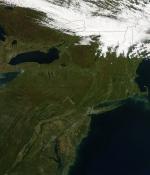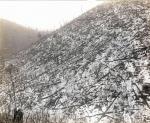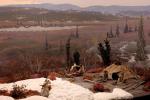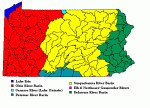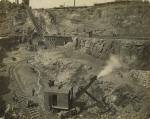Overview: Pennsylvanians and the Environment
"It is probable that in all the world there exists no other 45,000-square mile area equal to Pennsylvania in the wealth of its resources and the range of its products. It leads the entire hemisphere in the production of steel, zinc, pig iron, coal, coke, glass, cement…. Its past prosperity resulted from the existence of abundant natural resources. Its continued prosperity depends upon the use of its renewable resources in a manner which will insure the availability of these resources for generations yet unborn."
William F. Schultz, Jr., Conservation Law, 1953When William Schultz wrote his history of conservation law in Pennsylvania, the state was still an industrial powerhouse, a powerhouse made possible by its abundant natural resources. In the early 1950s, Schultz and others were deeply concerned about the state of Pennsylvania's environment. Of the more than thirteen million acres once farmed in Pennsylvania, more than five million had been lost to the erosion of topsoil. Pollution had rendered much of the state's flowing streams and rivers unusable. "Only suicides, uninformed children, and the mentally deficient," Schultz wrote, "voluntarily dive into the lower Monongahela, the lower Allegheny or the upper Ohio."
Pennsylvania communities suffered from growing shortages of ground water. In the late nineteenth and early twentieth centuries, miners had scraped and stripped the countryside to obtain minerals close to the surface, then abandoned it. Forests had been clear-cut, destroyed by fires and damaged by insects and disease. Flooding, which many feared was becoming more severe, occurred as soil washed into streams, leaving the exposed earth to bake hard.
This was a far different world than the one Native Americans had inhabited for more than 16,000 years, or the one the first European settlers had found when they arrived in the seventeenth century. When King Charles II granted William Penn his North American colony in 1681, the province was covered with trees. Pennsylvania lies in the middle of the transitional zone between the great northern and southern forests of eastern North America. In Pennsylvania the mixed hardwoods of the southern forests – the broadleaf oak, hickory, chestnut and walnut – merged into mixed softwood and hardwood forests of the north – the great white pine, hemlock, sugar maple, beech and birch.
In Pennsylvania the winters were colder and the summers hotter than in England, but compared to much of the world it was still a mild climate, shaped by winds that swept east across the continent. The weather could vary tremendously, depending upon elevation and region - as anyone who has driven across the state in winter can testify. The abundant rainfall made the forests grow lush. This would be a boon to farmers, who found the rich soils of the coastal plains of the southeast, the limestone valleys of the lower Susquehanna, and the shores of Lake Erie to be ideal for agriculture. For a while Pennsylvania was the leading grain-producing state in the Union. Farmers in later generations, however, were dismayed that the soil in the rest of the state was better suited to growing trees than wheat or corn.
The plentiful rainfall also gave life to 83,000 miles of rivers and streams that channeled the abundant fresh waters back to the oceans in three great drainage systems: by way of the Allegheny to the Gulf of Mexico, and by way of the Delaware and Susquehanna to the Atlantic. The vast forests of Pennsylvania also made travel difficult. Trees 100 to 150 feet tall shut out the daylight and covered an understory littered with decaying logs, vines and shrubs that made passage nearly impossible. For the colonists, as for the Indians before them, the waterways were the major highways through the forests. They were also a source of sustenance, for they contained within them an abundance and variety of fish unseen in Europe for a thousand years.
Pennsylvania's forests, waters and meadows were home to a wide variety of plants, insects and animals. European settlers were astonished and thrilled by the abundance and size of the deer, elk and beaver, the sturgeon, shad and trout. They hunted them all with a relish and greed that would bring these and other species to the brink of extinction within 200 years. Not all the forest's inhabitants were so desirable. Wolves and panthers roamed Penn's woods, and as an explorer in the Allegheny would recount, the province was filled with "stinging flies and diverse other insects but particularly Muskeetose in this country are like to rival the Seven Plagues of Egypt."
Endless trees, rich soils and abundant wildlife were not all that Pennsylvania offered. Beneath the canopy of trees, Pennsylvania contained vast deposits of coal, iron, natural gas, slate, clay, sandstone, limestone and sand. Slimy ooze called "Seneca oil" would make Pennsylvania the birthplace of the American oil industry and, for a while, the greatest producer and exporter of oil in the world. As Schultz explained, it was the great bounty of nature that made Pennsylvania a cradle of American industry and an economic powerhouse.
In the nineteenth century, Pennsylvanians cut, mined, quarried, hunted, harvested and in others ways extracted nature's bounty with unrelenting enthusiasm and voraciousness. By the end of the century, polluted waterways, denuded landscapes, impoverished soils, extinct and disappearing plant and animal life and foul air motivated many to embrace new conservation and preservation ethics that they hoped would restore the state's vanished bounty.
To protect its natural resources and public health, the Commonwealth of Pennsylvania passed a broad network of laws to restrict the pollution of its waters and air, protect wildlife and regulate extraction of natural resources. It established fish, game and forest commissions to conserve and manage its invaluable resources for future generations. In the twentieth century it acquired more than four million acres of land and established twenty state forests for timber conservation, plant and wildlife preservation, and recreation.
Pennsylvanians played major roles in the national resource conservation, wilderness preservation and environmental protection movements of the twentieth century. As Pennsylvania moved from an extractive and industrial to a mixed economy, parts of the forests, water, air and wildlife rebounded.
But in the twentieth century, old challenges endured and new threats emerged, both natural and man-made. Chestnut blight, gypsy moths and hungry deer attacked Penn's woods. Leaded gasoline, acid rain, DDT, PCBs and other environmental carcinogens polluted the water and the air, wreaking havoc on creatures great and small. Suburban sprawl tore up and paved over some of the world's richest soils as extractive industries, developers, conservationists, preservationists and others continued their struggle over the meaning and the use of nature's bounty.









